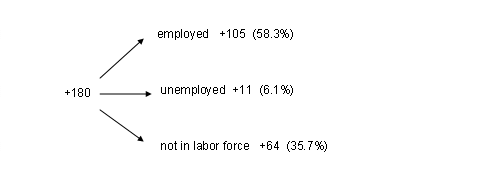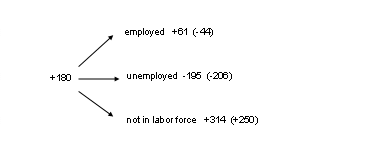There might seem to be some conflicting signals from Friday’s employment report from the Bureau of Labor Statistics. But I see a uniform message in the various numbers– the economic recovery remains disappointingly weak.
The BLS reports data from two different sources. The first source is a survey in which individual establishments are asked how many people are employed at that establishment. According to this survey, the number of people employed increased on a seasonally adjusted basis by 103,000 in December, a disappointing number given the needs of so many people to find work. A silver lining was that the November gain, originally reported as only 39,000, was revised up to a now-estimated gain of 71,000 jobs, and the October gain, which last month was estimated to be 172,000, was revised up to 210,000. If good news comes in threes, the December numbers could end up being favorably revised as well. As currently reported, the average over the last three months would be 128,000 net new jobs each month.
A second data source used by the BLS is a survey of individual households, in which residents are asked whether or not they are working. According to this survey, 297,000 more Americans were working in December than in November on a seasonally adjusted basis. The household survey is also the basis for the BLS estimate of the unemployment rate, which fell from 9.8% in November to 9.4% in December. We haven’t seen that big a 1-month drop in the unemployment rate since 1998. So maybe the establishment numbers were erring on the pessimistic side?
Unfortunately, the household numbers look much less rosy when you look at them a little more closely. For one thing, the impressive December gain comes right after an estimated loss according to the household survey of 175,000 jobs in November and a whopping loss of 294,000 in October. How can the household survey be signaling a falling unemployment rate over the last 3 months if its measure of the number of people working has actually gone down?
To answer that question, let’s take a look at how the BLS summarizes the responses people give to the household survey. They count as employed someone who did any work at all as a paid employee or worked in their own business during the surveyed week, and also people who have a regular job but missed work due to temporary factors such as illness or labor disputes. To be counted as “unemployed”, the person must not meet those first criteria and also must have made specific efforts such as contacting potential employers during the last 4 weeks to try to find a job. Any member of the civilian noninstitutional population over age 16 who doesn’t fall into one of the above two categories is designated to be “not in the labor force.” In December, 58% of the eligible population were employed, 6% were unemployed, and the remaining 36% were classified as not in the labor force.
Let me use an average over the last two months to smooth out some of the wild volatility in the household employment numbers and highlight what’s changed in terms of people’s employment status. In November and December, the civilian noninstitutional population over age 16 increased by 180,000 per month. The figure below illustrates what would have happened if these new people had entered into the respective employment categories at the same rate as the existing population. For example, if 58% of those 180,000 new potential workers found jobs, the number of employed individuals would have increased by 105,000 each month. If in December the number of employed had increased by 105,000, the number of unemployed increased by 11,000, and the number not in the labor force by 64,000, then measures such as the unemployment rate and the labor force participation rate would have been unchanged.

|
But we know that in reality, the unemployment rate was not unchanged, but fell from 9.7% in October to 9.4% in December. The figure below shows that this is attributable mathematically to the fact that almost 200,000 fewer workers were counted as being unemployed in December compared with October.

|
We can also calculate the difference between what actually happened and the hypothetical values that would have kept the unemployment rate constant. Those numbers are reported in parentheses in the figure above. None of the drop in the number of unemployed over the last two months is due to an increase in the number of people with jobs. In fact, according to the household survey measures, there were 44,000 fewer new jobs per month than were needed to accommodate the growing population, let alone to provide work opportunities for those currently unemployed. The big move was from people who used to be counted as “unemployed” but are now designated as no longer in the labor force.
The next figure provides some long-term perspective, plotting the count of those not in the labor force as a percentage of the eligible population; (this is the same as 100 minus the labor force participation rate). There was a steady decline in the percentage of those not in the labor force during the 1970s and 1980s, owing largely to increased employment rates for women. That trend started to reverse over the last decade, with a sharp increase in nonparticipation rates coming out of the last recession. It’s that increasing tendency to drop out of the labor force that accounts for an improving unemployment rate in the face of quite weak job growth.

|
And, given the circumstances in which we’re seeing people dropping out of the labor force, it’s hard to greet the decrease in the unemployment rate as good news; see Justin Lahart and Calculated Risk for more discussion. The household survey thus in my mind confirms the inference from the establishment survey: this is still a much weaker job market than we want and expect for this phase in the recovery.
Household survey employment has fallen by 176k since April, 2010.
The broader question is why the Household survey has been unable to detect an uptick in employment for close to three quarters of recovery.
One possibility is low net business formation. In that case, the upcoming birth/death revision will eliminate much of the post-April 550k increase in employment from the Establishment survey. Perhaps, post revisions, we will still see an acceleration in 4q.
Mr. Hamilton,
This is good work and done with an objective eye. It was a bit disconcerting to see some of the questionable reasoning, at least from my perspective, you were employing in parts of ’09 and ’10 to predict a strong recovery, but now that it hasn’t quite panned out your objectivity as been spot on. Many are still out there still arguing that were in a recovery and somewhere down the road it’s just ready to take off–and in all fairness, the ultra pessimists didn’t turn out right in 2010, but I think they will turn out right before the Presidential election (a 50% chance of a double dip this year, a 90% chance next year–and very likely the S&P doesn’t hold up as profit margins get crushed).
In any case, Mr. Hamilton, you would’ve been someone I would’ve considered ultra optimistic and on the verge of irrationality (and we’re all prone to this), but lately the analysis you’ve been giving is of excellent quality. We tend to lose out reasoning quickly and as a mass, and only regain it slowly, and as individuals; this is true for all of us, but some of us never regain it. I applaud you, it is a very difficult thing to do to reassess the situation according to the what the environment is telling us, as opposed to us demanding how the environment should behave.
Exactly. Spot on. There is nothing to rejoice about the latest job numbers, in fact, its a sobering reminder that the USA might not be in sustainable recovery now nor anytime during 2011 or 2012, once the monetary “wealth effect” withers out and QE3 either kills dollar denominated assets or is not launched.
Result will be the same. Double dip in late 2011, and a truly disastrous 2012.
Brian: I think you completely mischaracterize my statements, and defy you to find any occasion on which I “predicted a strong recovery.” Everything I’ve said and predicted is a matter of public record, and my impression is that I have been extremely accurate over the last two years.
I did declare in April 2010 that the recession was over, and that 2009:Q2 was the last quarter of the recession. Is it possible that you are one of the readers who still hasn’t figured out that statement was 100% accurate?
Professor,
Very good analysis!!
I am hopeful going forward. Businesses will probably assume that a divided government due to Republican control of the House will be a more consistent governmental regulation environment. Businesses can deal with horrible government policy as long as it is consistent and that could translate into more employment. What businesses can’t deal with is uncertainty and that means unemployment. The caveat in this is if the Obama administration shifts uncertainty from congress to the bureaucracy, for example cap-and-trade implemented by the EPA.
Just one other thing to consider in your calculation. With the increase in unemployment insurance in the lame duck congress fewer people will be looking for work. As they say we can have just as much unemployment as we are willing to pay for. Fewer people looking for work will bring down the unemployment rate even though the number of employed goes down or doesn’t change.
But Brian says your bout of irrationality is ova (we are all prone to this) so not to worry, unless it kicks in again…which it could. And that is why he has your back.
QED.
He’s just sayin you should watch out for fast-draining reasoning that infects the masses…and, tellingly, some individuals in it…if you want anymore applause from him.
Ok, back to battling that demanding environment…
The 4% Rule gives an oil price tolerance for the US of $86 / barrel for year-end 2010. We’ve been above that for much of the last month, a level normally associated with reduced consumption of oil (indeed, recession).
By extension, therefore, the economy would seem to be energy- (or more precisely, mobility-) constrained. Therefore, if the economy cannot count on additional oil to provide mobility, re-employment will be lower than it would be otherwise–and so I have asserted for a year.
So my forecast has proved true, but is it right? Can we distinguish between the lingering impact of the financial crisis and oil-price constraints clearly enough to make a compelling argument? Or is it simply coincidence?
Between the four major sources of employment news (weekly claims, CPS, CES and ADP) all of them are steadily improving. CES is the most widely followed and unfortunately it is improving the slowest. Weekly claims recently dipped below 400,000 for the first time since pre-lehman. I think this is extraodinarily bullish. On top of that, the S&P 500 has had remarkable momentum and stability of late.
Unemployment wasn’t extended beyond 99 weeks and it seems fairly clear from the data, there has been no employment rush from its end, only a decrease in the workforce as people leave it. It kept unemployment up but only by keeping them in the workforce.
I agree with Lord.
Stop paying people to follow the beurocratic process and they’ll stop following it.
With UE checks:
Q: Looking for work?
A: Yes sir, applied at A, B and C.
Without UE checks:
Q: Looking for work?
A: Mind your own d### business.
Signs of a stronger economy are showing up almost everywhere but the BLS employment report.
Don’t understand Lord at all, how can there be an “employment rush from its end,” without a rush of new jobs created at it’s end? Which there wasn’t.
And even more cryptic is KevinM’s cute story, which we all know is a certain type of political brand, and nothing to do with economics.
“It’s that increasing tendency to drop out of the labor force that accounts for an improving unemployment rate in the face of quite weak job growth.”
It’s not a drop out but a force out. Two totally different concepts. Every sports fan knows the difference.
Conservatives constantly push that unemployment compensation increases unemployment and that ending it will cause the unemployed to seek and find real employment. Some have predicted a groundswell of employment for that reason. That doesn’t look like the case.
Steven:
“So my forecast has proved true, but is it right? Can we distinguish between the lingering impact of the financial crisis and oil-price constraints clearly enough to make a compelling argument? Or is it simply coincidence?”
The current increases in oil prices are the consequence of financial crisis as solid assets are sought. The lingering of financial crisis will last 10 years, not just a few. As the USA puts out more export in terms of its best export item, USD printing, a lot of these USD goes into oil and other commodities. Oil is safer than gold since there is also a growing demand story that some still believe in a validating extremely high prices of oil.
So it is not a coincidence. QE-> higher oil prices-> drag on economy-> less employment increase-> drag on economy-> more QE ( seems like that machine is unstoppable right now)-> higher oil prices -> more drag on economy-> less employment increase-> what next?
Continuing like this, sooner than later the USA will have to take action to protect the value of its main “export” – USD vs. commodities.
UE doesn’t pay well, 60 % of previous wage and no health care. Health insurance can wipe an UE check by itself.///
Didn’t the IMF do a study of financial crises and aren’t we tracking the typical (weak) recovery spot on ?